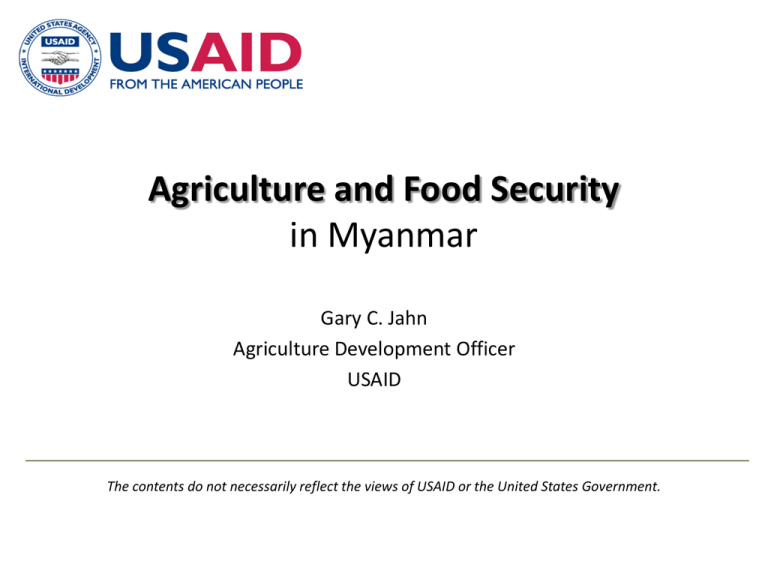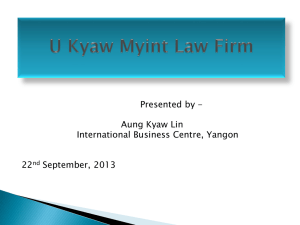Preliminary Observations of the Myanmar Agricultural Sector
advertisement

Agriculture and Food Security in Myanmar Gary C. Jahn Agriculture Development Officer USAID The contents do not necessarily reflect the views of USAID or the United States Government. Sources • Michigan State University / MDRI Agriculture and Food Security Diagnostic for Myanmar (USAID 2013) • USAID 2013 Land Tenure and Property Rights Assessment of Myanmar • ASH Center Studies 2009-2012 • ADB Agriculture Sector Assessment, Myanmar 20122014 • Discussion Paper No. 63. Agricultural Policies and Development of Myanmar’s Agriculture Sector (IDE 2006) Asia Source: http://wwp.greenwichmeantime.com/time-zone/asia/_derived/index.htm_txt_map-of-asia.gif Potential of Myanmar for Agriculture High Potential • Exceptional resources (water, land, location, climate) – Water: 10 times as much per capita as China and India; 2 times as much as Vietnam, Thailand and Bangladesh – Land: 14 million acres virgin and fallow; 83 million acres of forest – Strategic location: near major regional markets • Diverse ecosystems diversification potential • Relatively low population pressure • High potential for increased land use Population Densities Population Land area (sq mi) Density per sq mi Myanmar (Burma) 47,382,633 253,954 187 Cambodia 13,881,427 68,154 204 Thailand 64,631,595 197,595 327 1,313,973,713 3,600,927 365 84,402,966 125,622 672 1,095,351,995 1,147,949 954 147,365,352 51,703 2,850 Country China Vietnam India Bangladesh Source: http://www.infoplease.com/ipa/A0934666.html How crowded is Myanmar? How crowded is Myanmar? How big is Myanmar? Source: http://www.infoplease.com/ipa/A0934666.html Percentage of land used for agriculture by each country Source: http://data.worldbank.org/indicator/AG.LND.AGRI.ZS So how does Myanmar compare to the region? • • • • • GDP per capita? Farm income? % in poverty? Food security: affordability, availability, safety? Malnutrition? Low incomes, high poverty South Korea Malaysia Indonesia Thailand Bangladesh Cambodia Vietnam Myanmar Agricultural Poverty income per (%< worker $1.25/day) $19,807 $6,680 4 $730 3 $706 8 $507 11 $434 5 $367 4 $194 26 Status of Myanmar in Region Source: CIA World Factbook - accurate as of January 1, 2012 http://www.indexmundi.com/g/r.aspx?v=67 Food Security in Region Malaysia Vietnam India Myanmar Thailand Bangladesh Sri Lanka Pakistan Nepal Cambodia Malnutrition: Deaths per 100,000 Source: WHO, World Bank, UNESCO, CIA , country databases for global health and causes of death. http://www.worldlifeexpectancy.com/cause-of-death/malnutrition/by-country/ High levels of food insecurity: Stunting by state/region Lowest % of agricultural products imported (2010) Equatorial Guinea 2 American Samoa 3 Singapore 4 Argentina 5 India China, Hong 6 Kong SAR 7 Thailand 8 Republic of Korea 9 Australia United States of 10 America 11 Zambia 12 Brazil 13 China 1 2.40 % 2.87 % 2.94 % 2.95 % 2.97 % 3.85 % 4.06 % 4.42 % 4.53 % 4.53 % 4.63 % 4.82 % 4.95 % Source: http://faostat.fao.org/site/342/default.aspx; http://www.english.globalarabnetwork.com/200908302449/Related-news-fromSaudi/saudi-arabia-food-a-agricultural-imports-to-grow-by-25-in-2009.html Highest % of agricultural products imported (2010) 11 Haiti 30.11 % 12 Sao Tome and Principe 28.85 % 13 Tonga 14 Cape Verde 15 Tuvalu 16 Yemen 17 Samoa 18 Myanmar 28.22 % 27.54 % 27.44 % 27.15 % 26.50 % 25.54 % 19 Solomon Islands 25.41 % 20 Senegal 24.94 % Source: http://faostat.fao.org/site/342/default.aspx; http://www.caribbean360.com/index.php/news/barbados_news/182495.html; http://www.presstv.ir/detail/37413.html Poverty & food security indicators In Southeast Asia, Myanmar has: • Lowest GDP per capita, • Low food affordability and availability • High malnutrition, • Lowest farm incomes • High import of agricultural products Historical Agricultural Performance • Example: rice & bean exports http://www.myspace.com/123945320/photos/11106187#%7B%22ImageId%22%3A11106187%7D World’s Top Rice Exporters 1961 Source: http://faostat.fao.org/site/342/default.aspx World’s Top Rice Exporters Today Source: http://faostat.fao.org/site/342/default.aspx World’s top Bean Exporters 1961 World’s Top Bean Exporters Today Source: http://faostat.fao.org/site/342/default.aspx Myanmar rice production Rice production (millions of tons) ~8 million ha paddy ~5 million ha paddy Why did beans out-perform rice in Myanmar? Fujita & Okamoto (2006) found: • After 1988, sluggish growth in all crops covered by policy constraints • But a self-sustaining increase in output of crops outside the remit of agricultural policy • Today pulses and beans are Myanmar’s largest export item What were these policies? In the socialist period: • Farmers required to sell rice to government at below market prices • A system of rationing cheap rice to consumers through shops and cooperatives • Subsidized transport for rice – lowering price in boader areas • Government monopoly on rice exports What was the result? • Link between supply & demand broken • Domestic rice prices & farm income kept artificially low • Farmers had no incentive (or means) to increase production; • Remote areas lacked incentive to produce cheap rice • No market driven demand for improved technology What about beans? • No compulsory sales to government at below market price. • No rationing • No government export monopoly • Bean prices rose in response to increased demand inside AND outside Myanmar • Production rose in response to increase demand for beans; demand for technology Why is agricultural productivity low? • • • • • • • • • Poor policies Poor water control High transport and transaction costs Conflict Land access, ownership, use Limited budgets for key supporting ministries Structure of agricultural support institutions Traders well-organized, farmers not Weak data Let’s discuss current agricultural policies and how they are affecting agricultural development and food security.











